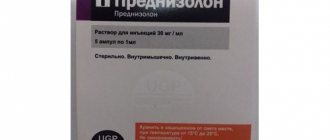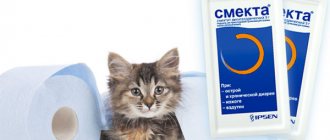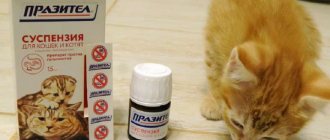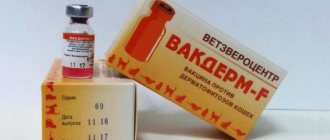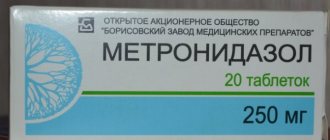In veterinary medicine, the drug Trichopolum is actively used to treat cats. It is a broad-spectrum antibiotic characterized by pronounced anti-inflammatory, antiprotozoal and antibacterial activity. "Trichopol" is highly effective, and it should be used for four-legged pets strictly as prescribed by a veterinarian, after studying the instructions for use attached to the veterinary drug.
Composition and action
The active component of the antibiotic is metronidazole. It has the ability to influence the DNA synthesis of pathogenic cells, which stops their development and causes the death of pathogenic bacteria. Metronidazole is active against Giardia, Trichomonas, Histomonas, and some anaerobes - pathogenic microorganisms that do not require oxygen for their life and development.
Trichopolum begins to act quickly after administration; after 2 hours, the maximum concentration of the active substance is reached in the blood and plasma, which is quickly distributed through the bloodstream throughout all systems and organs.
Important!
The effect of the drug slows down if you give it to your pet with food or immediately after feeding.
Trichopolum has several dosage forms: tablets, injection solution, ointment, gel, rectal suppositories. To treat pets, tablets are usually used - a more affordable and easy-to-use drug.
Metronidazole for cats with diarrhea
Unfortunately, cats often suffer from diarrhea, especially at an early age. The body's systems are not yet strong, they are not working at full capacity, and any, even harmless, change in diet can lead to gastrointestinal problems.
In cases where the cat’s health situation is critical and it is not possible to get to the nearest veterinary center or call a specialist at home, you should follow the rules:
- take the required amount of Metronidazole tablet, crush it;
- dilute with water, pour into a syringe and forcefully pour it into the cat’s throat, or mix the medicine with food and make sure the pet eats it.
Can be treated with Metronidazole intravenously. This is usually done in severe cases and in medical institutions. The duration of such treatment is 3 days. Then you can switch to tablets. If recovery occurs within these 3 days, it is better to stop using the medicine.
Purpose
Trichopolum is prescribed by a veterinarian for the treatment of domestic cats with the following diseases:
- giardiasis;
- trichomoniasis;
- balanthiosis;
- dysentery;
- necrobacteriosis;
- aphthous stomatitis;
- postpartum infections;
- other bacterial infections.
Trichopolum may be effective for diseases accompanied by intestinal upset and prolonged diarrhea. However, in any situation, you cannot use the medicine unknowingly, without a veterinarian’s prescription - in some cases, taking Trichopolum may not be advisable.
Important!
The drug has contraindications for use, so it cannot be used for self-medication.
Giardiasis is a dangerous infection that is chronic. Small kittens and animals kept in crowded conditions, such as in a shelter, are more susceptible to it. Penetrating into the animal's body, Giardia - pathogenic microorganisms - damage the villi of the lining of the small intestine. Giardia is anaerobic; they do not require oxygen for reproduction and life, so they are highly virulent: a sick animal very quickly infects its relatives who come into contact with it.
The danger of infection is that parasites release toxic substances during their life. They cause damage to the intestinal mucosa, reduce the absorption of nutrients and contribute to the development of pathogenic microflora in the intestines. Prolonged diarrhea can result in dehydration, which can be fatal.
Important!
Giardia in a pet's body can cause complex allergic reactions that cannot be treated.
Another danger of the disease is the vagueness of the clinical picture, as a result of which professional treatment begins late: most often, owners associate diarrhea with overeating or simple malaise. In addition, giardiasis can be completely asymptomatic. Common manifestations of the disease include:
- chronic diarrhea with watery yellowish stool. May have a foul odor, contain mucus and blood;
- weight loss with normal appetite;
- dry skin;
- deterioration in appearance – the coat becomes dull and brittle;
- allergic dermatitis;
- cough.
Giardia can affect various organs, which is accompanied by characteristic symptoms. For example, when parasites accumulate in the gallbladder ducts, liver function is disrupted.
Important!
Parasites are very tenacious in the environment, are not sensitive to the effects of chlorine and ultraviolet radiation, and in conditions of high humidity their ability to survive and reproduce increases.
In such conditions, it is possible to fight parasites only with the help of strong antibacterial drugs, one of which is Trichopolum.
When is it appointed?
Trichomonas infection is one of the indications for the use of the drug.
The official instructions for use and experienced veterinarians, one of whom is V.I. Pakhomkin, Candidate of Veterinary Sciences, recommend using “Trichopol” for diarrhea, trichomoniasis, dysentery and balantiosis. In addition, kittens are prescribed medication to treat gingivitis, aphthous stomatitis and malignant edema. Whatever the indications for taking Trichopolum, its use is not always effective. Only a qualified specialist can determine the advisability of using medication to treat pets. And a veterinary laboratory will help him with this, allowing him to reliably identify the sensitivity of pathogenic microorganisms to antibiotics. Without laboratory testing, the effectiveness of metronidazole may not be sufficient. If you give Trichopolum to a cat without permission, you can expose your four-legged pet to an unreasonable risk.
Dosage
The manufacturer's general recommendations provide for a single dose of the active substance - 10 mg per 1 kg of body weight. It is very difficult to calculate it yourself, taking into account the fact that 1 tablet contains 250 mg of metronidazole. The veterinarian creates a treatment plan for each pet individually.
The medicine should be given twice a day between feedings, forcibly: fixing the cat’s head, put the tablet in the mouth on the side of the tongue, hold the mouth closed, stroking the throat to evoke a swallowing reflex. The tablets are bitter, so you can immediately drink some water so that the cat swallows the medicine.
Important!
To maximize the therapeutic effect, it is recommended to give the medicine at the same time every day.
Typically, the course of treatment is 5-7 days; depending on the severity of the disease and the physiological characteristics of the animal, the veterinarian may change the dosage and duration of treatment.
How to give Metronidazole to your pet
For diarrhea, the drug should be given as follows:
- Crush half the tablet.
- Add some water.
- Inject it into the cat through a syringe.
It can also be administered into a vein through a dropper. This approach is appropriate when the disease is in the acute stage. Therapy is carried out for no more than 3 days. Subsequently, you need to switch to tablets.
Remember that only a doctor should prescribe the dosage!
Cost of the drug:
- in a bottle 5 mg/ml (100 ml) – 50-160 rubles;
- a pack of tablets (250 pieces) – 270-300 rubles;
- a jar of one thousand tablets costs 1,550 rubles.
Limitations and side effects
Do not exceed the dose prescribed by the veterinarian: this can cause nausea, vomiting, dizziness, weakness and unsteady gait in the cat. In weakened animals, involuntary muscle contractions and ataxia (impaired coordination of movements) are possible. Trichopolum does not have an antidote; symptomatic and supportive treatment is used.
The basis for replacing the drug is the presence of individual hypersensitivity to the main therapeutic component - metronidazole. In addition, the following pathologies are prohibited from using Trichopolum:
- liver dysfunction;
- leukopenia;
- lesions of the central nervous system, in particular epilepsy and others.
Pregnant and lactating cats and kittens under 8 months of age should not be treated with the drug.
Instructions for use
According to the instructions for use, you should follow safety rules when working with the medication. Before working with the drug, you must wash your hands with soap. During the manipulations, you should not smoke, eat or drink drinks.
After finishing working with the medication, you need to wash your hands. It is recommended to avoid direct contact with the drug. If the antibiotic gets on the skin or mucous membranes, rinse the contact area with plenty of water. If the drug enters the body, you must immediately contact the nearest medical facility for help.
During treatment, it is necessary to follow the correct regimen for the animal. To avoid scratches and injuries from animals while taking the drug orally, you should wrap your pet in a towel or any soft cloth. For convenience, injections can be given by a veterinarian.
There are certain rules for treating diarrhea in an animal that should be followed:
- 1. crush half the tablet;
- 2.dilute the tablet with water;
- 3. pour the solution into the syringe;
- 4. Pour the solution into the animal’s mouth or mix with food.
Storage conditions: at temperatures from -10 to +40 °C. The medicine should be stored out of the reach of children. Shelf life: three years from the date of production. After the expiration date, the use of the medication should be discontinued.
Trichopolum in the treatment of cystitis
The development of infectious and inflammatory reactions in the mucous tissues of the bladder reservoir is one of the quite frequently diagnosed pathologies in the female urinary system.
The genesis of the disease is due to the influence of bacteria, viruses or fungal flora. The choice of the necessary drug directly depends on the specific pathogen and is used to relieve reactions of infectious inflammation. Trichopolum for cystitis is one of many drugs that can quickly relieve patients from the unpleasant symptoms of the disease.
What not to do
In order not to provoke complications and achieve results in treatment, it is important to follow the following rules:
- Do not give antibiotics without a doctor's prescription.
- get rid of the smells of household chemicals and other heavy odors in the apartment.
- do not increase the safe period of treatment.
- You cannot let the animal go outside.
- Do not give dry food if you have diarrhea.
For safe treatment, you should always contact a professional. This condition will allow you to avoid complications and cure your cat in the most painless way possible. The doctor will tell you exactly what you can give your cat for diarrhea and will draw up a treatment plan and identify the cause of the poor health. Your pet may need a special diet or nutrition plan.
Treating cats usually requires special medications designed for animals. They are produced taking into account the metabolic characteristics of representatives of the cat family, which allows you to extract maximum benefit from the medicinal substance and avoid unwanted effects. However, there are a number of products that are suitable for both people and cats. They are sold in regular pharmacies without a prescription.
One of these drugs is Metronidazole and its analogues based on the active substance of the same name (for example, Trichopolum). What diseases in cats can be treated with metronidazole? How to correctly calculate the required dose? What is the most convenient method of administration?
Recommendations from experts
To avoid serious health problems for your pet, you should regularly prevent parasite infestation. Cats, especially those that go outside, are prone to developing enterobiasis, head lice, fleas and other pests.
Metronidazole may not always help cats, so at the first symptoms of infection, you should contact a veterinarian for appropriate help.
If your pet has diarrhea and is unable to visit a doctor, you can give the drug to your pet yourself, but only after correctly calculating the dose. Even if the symptoms stop after this, you still need to seek advice from a specialist.
Metronidazole can be stored at temperatures from -10 to +40 without loss of therapeutic properties, the main thing is not to leave the medication in open sunlight and with free access to children. You can purchase the drug at any pharmacy at an average cost of 25 rubles.
Caring for a sick cat
During treatment, a sick cat must be provided with rest, a warm room with bedding, and isolation from children and healthy animals. The tray should be removed immediately after contamination. Do not massage, palpate or warm your pet's belly.
You should rinse your drinking bowl daily and fill it only with bottled water. If there is a lack of fluid, the veterinarian may recommend supplementing the cat with a syringe. After the injections, you should please the cat with treats, affection and praise.
Contraindications
Despite the popularity and widespread use of this drug, there are certain contraindications for its use in animals:
- Having a cat with allergies is a serious reason to refuse medication. Naturally, it is advisable to discuss this issue with a veterinarian. If the situation worsens, the use of corticosteroids may be necessary. Such parallel treatment may worsen the animal’s condition.
Liver failure.
During lactation, most of the components end up in the cat's milk, which loses its taste, becoming bitter, and also negatively affects the health of the kittens. They may develop gastrointestinal diseases and allergies. Deaths are quite rare. It is necessary to isolate kittens in a timely manner and implement artificial nutrition. Only on the third day after taking Metronidazole can you resume breastfeeding; in general, this is quite difficult to do and the kittens will have to be fed independently until they learn to eat on their own.
- Taking Metronidazole during pregnancy affects the condition of the cat, as well as unborn kittens. At present, the effect of the drug during pregnancy has not been fully studied, but there have been cases where the cat’s health deteriorated significantly.
Analogues of the drug
Metronidazole is the main or constituent part of many medications. Complete analogues containing the same active substance as the claimed drug are:
- trichopolum;
- metrogil;
- flagyl.
Drugs based on ornidazole and tinidazole have a similar effect, however, all drug changes must be agreed with your doctor.
Did you know? Initially, the substance was considered only a remedy for trichomoniasis and was used as an antiprotozoal medicine. The antibacterial effect was discovered by chance when the patient was simultaneously cured of bacterial gingivitis.
Indications
Frequent parasitic infections in cats are a direct indication for the use of this remedy. Pathogenic microorganisms and bacteria can disable the entire body, manifesting itself in infectious disorders, inflammation, the formation of ulcers in the digestive tract, edema and even gangrene. Due to the harmful effects of parasite waste products on animal tissues and organs, a number of characteristic unpleasant symptoms may occur. To eliminate the painful manifestations of parasitic effects, veterinarians can prescribe Trichopolum to a cat with diarrhea.
In what cases is Trichopolum prescribed to cats?:
- Postpartum anaerobic infections;
- Manifestations of dysentery;
- Diarrhea;
- With balanthiosis;
- For trichomoniasis;
- In the presence of malignant edema;
- For aphthous stomatitis;
- For gingivitis;
- During necrobacteriosis.
This medicine is prescribed only after a complete laboratory examination of the animal. Trichopolum may not help with some types of pathogenic lesions, since not all microbial microorganisms are susceptible to metronidazole. It is for this reason that Trichopolum should not be given to a cat without permission, so as not to expose the pet to an unreasonable risk.
